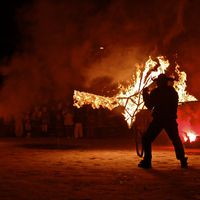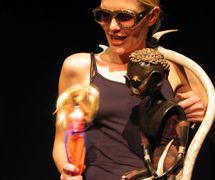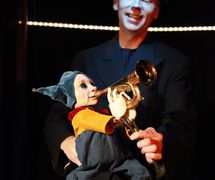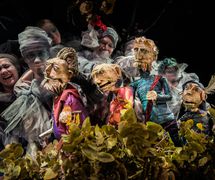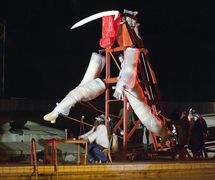A Nordic country located in Northern Europe, the Republic of Finland (Finnish: Suomen tasavalta) is bordered by Sweden to the west, Norway to the north, and Russia to the east.
Like the other Nordic countries, Finland lacks a long puppet theatre tradition. Some folkloric manifestations could be considered reminiscent of puppet and mask theatre, such as the masks and effigies used in the feasts and rituals accompanying the killing of a bear (karhunpeijaiset), or the masks and disguises of the nuuttipukit, groups of strolling players who went from door to door at the end of the Christmas festivities. In fact, Finland only joined in the practices of other European countries in the 19th century. Itinerant European troupes touring Stockholm and Saint Petersburg passed through Finland, staging their pieces for string marionettes, trick and transformation puppets or showing their theatrum mundi. At the beginning of the 20th century, the pioneers of the Finnish puppet theatre gave their first shows: Kalle Nyström (1865-1933) and his string puppets; Bärbi Luther (1889-1979), a kindergarten teacher, and her shadow theatre; and, in the 1930s, Arvo Avenius (1901-1972), a circus artist, who gave trick puppet shows.
After World War II, two noteworthy visits from abroad were made to Finland: in 1949, the French Jacques Chesnais and, in 1950, the Russian Sergei Obraztsov. They inspired an enthusiasm which encouraged Finnish puppeteers to give performances reflecting their influence. Inspired by her travels in Germany and France, the writer, Annikki Setälä (1900-1970), established her own puppet theatre in Lapland, the Lapin Nukketeatteri (Lapland Puppet Theatre) in Rovaniemi, up to the 1960s. Mona Leo (1903-1989) instituted the Helsingfors Dockteater-Helsingin Nukketeatteri (Helsinki Puppet Theatre) in 1952. Leo’s poetic performances, rooted in her humanist interpretation of fairy tales, were performed internationally. The Kasper-teatteri (Kasper Theatre), related to its central European cousins, was founded in the 1960s by Irja Ranin (1939-1995) and Matti Ranin (1926-2013); in addition to playing in conventional venues, it appeared on children’s television, Niksulan TV, for nearly thirty years.
The 1970s to the Present
Certain persistent women artists were responsible for the success of the puppet theatre, until then regarded as the poor relation of the performing arts. The 1970s saw the foundation of five professional puppet theatre companies. In 1971, director Sirppa Sivori-Asp (1928-2006) was one of the founders of Nukketeatteri Vihreä Omena (Green Apple Puppet Theatre), the first truly professional puppet theatre company in Finland which was active for more than thirty years. She was its artistic director until the 1990s. Her successor was Ulla Raitahalme until 2004, when the theatre was closed.
Teatteri Hevosenkenkä (Horseshoe Theatre) was established in Espoo in 1975 by director Kirsi Aropaltio (today Kirsi Siren) and stage designer Sara Siren. The company created many new plays for puppets, some of which were regularly performed in the Finnish National Theatre in Helsinki. Nukketeatteri Sampo (Puppet Theatre Sampo) was founded in Helsinki in 1977 by Maija Barič and Bojan Barič, both graduates of the Academy of Performing Arts in Prague. In the western coastal city of Vaasa the bilingual Teatteri Peukalopotti/Teatern Tummetott (Little Thumb Theatre) was established in 1976. Later, its artistic director, Kristiina Hurmerinta, and the Polish puppeteer Anna Proszkowska, created a second company, Pandoran Näyttämö (Pandora´s Stage), an avant-garde visual theatre aimed at adult audiences. Both Vaasa theatres were closed in 1996. Teatteri Mukamas (Mukamas Theatre) was founded in 1979 in Tampere. The visual poetry of the shows was essentially the work of two artists, the director Mansi Stycz and stage designer Anna-Liisa Tarvainen.
These five companies (by 2011 only three were left), were or are annually subsidized by the Finnish government and provided by their municipalities. They formed the cornerstone of professional puppetry in Finland.
The artistic potential of Finnish puppet theatre was enhanced by two influential artists, Kirsti Huuhka and Mirjami Skarp, who created puppets and sets for professional and amateur groups as well as for television. They are now being succeeded by the next generation of artists and puppet makers, notably Iida Vanttaja, Timo Nyyssönen and Virpi Tanskanen, and by the generation younger again, such as Johanna Latvala and Outi Herrainsilta.
A feature of Finnish puppet theatre is the large number of professional soloists. Today there are around thirty such performers in the country, many of them emerging from a new generation of innovative and professionally trained artists. These solo puppeteers are independent, only occasionally receiving bursaries or grants. They find their public in day care centres, schools, libraries and other social centres, their choice of shows naturally expressing their personal characteristics. While several of the pioneering theatres of the 1980s have recently closed their doors, such as Rainer Kaunisto’s Nukketeatteri Rooma (Rome Puppet Theatre) and Oili Sadeoja’s Teatteri Olga (Olga Theatre), others have continued. Since 1985, the widely travelled Helsinki-based Nukketeatteri Sytkyt (Puppet Theatre Sytkyt) of Juha Laukkanen has specialized in site-oriented performances in art museums and other places. Since 1989, Leila Peltonen toured in Lapland with her Matkalaukkuteatteri (Travel Case Theatre); she has drawn inspiration from her experiences working in Africa. Daughter Johanna Peltonen took over the theatre in 2011. Other solo puppeteers who have been performing since the 1980s and 90s, such as Matti Koskinen of Teatteri Vekkulikettu (Theatre Funnyfox) from Tampere and Kerttu Aaltonen of Nukketeatteri Piironginlaatikko (Puppet Theatre Drawer) from Uusikaupunki, continue to perform.
The popularity of puppetry has been given an extra boost by many puppetry houses located throughout Finland. Half-a-dozen puppetry houses organize activities all over the country: Nukketeatteritalo Mundo (House of Puppetry) in Turku and Nukketeatteritalo Nuketteri (House of Puppetry) in Perniö, southern Finland; Nukkekoti (Dollhouse) in Pieksämäki in the east; in Kangasala Teatteritalo Parvula (Theatre House) in western Finland; and Rovaniemi Puppet Theatre House in Lapland. The oldest and best known of the centres has been Musta ja Valkea Ratsu (Black and White Steed) which functioned until 2014 in Sysmä. Its soul was the artist Eeva-Liisa Holma-Kinnunen (1930-2014), the creator of Ransu the Dog, one of the most famous television puppet characters in Finland.
Amateur Companies
There are tens of active amateur puppet theatre companies in Finland, which have strongly contributed to the invigoration of the puppet theatre. The oldest of these had, by 2005, been in existence for over 30 years. The network includes all the cultural diversity of the country: from the southernmost Dockteater Fågel Blå in the Swedish-speaking Åland Islands to the northernmost Puppet Theatre Kompiainen in Kolari, Lapland. In the east, two Joensuu puppet theatres – Vunukka and Punahilkka – have been active for more than twenty years. Since 1984, in Kangasala (near Tampere), Puppet Theatre Hupilainen, founded by Sinikka Meurman and Niina Kettunen-Niemi, has greatly influenced the amateur puppetry field. This semi-professional company has been working with professional Finnish and Polish directors; it organizes an international festival every two years. In various parishes there are also several puppet theatres, which produce puppet plays based on Bible stories, such as Puppet Theatre Sananjalka based in Parikkala. The network of amateur puppet theatres in libraries and day nurseries have also made a strong contribution to puppetry in Finland.
Recent Developments
The world of Finnish puppetry has given birth to some interesting phenomena. There are new and interesting developments emerging in recent years that have influenced Finnish puppetry and have attracted local and international attention. These include joint organizations, such as Aura of Puppets in Turku, Puppet Theatre Centre Buoy in Helsinki, Turku International Puppetry Connection TIP, and Lapland Puppet Theatre Association in Rovaniemi, all instituted in 2007-2011. Since 1998, tens of new professional companies have entered the field of Finnish puppetry. New companies, like Sixfingers Theatre, Sudenenne (Wolf Sign Theatre), Kuuma Ankanpoikanen (Hot Duckling) and Maria Barič Company, are exploring new visual possibilities. In the northern city of Oulu, the Nukketeatteri Akseli Klonk, in the spirit of punk and rock, is under the direction of Janne Kuustie. The company produces shadow puppetry and object theatre, as well as street and mask theatre. The company’s unconventional and, at times, grotesque approach appeals to young, adolescent audiences who have no experience of puppet theatre.
New companies playing for adult audiences have been established, such as the Kollaasi Corp. in Turku. Puppet performances are also entering the stages of major city theatres. The option of studying “puppet animation” is in vogue in art schools, and talented film enthusiasts are emerging, such as Katarina Lillqvist, who won a Silver Bear at the Berlin Festival in 1996 for her film, Maalaislääkäri (Country Doctor), based on Franz Kafka’s short story.
Entering the 21st century, Regional Artists of Puppetry have worked in their respective Regional Arts Councils: Leila Peltonen in Lapland, Timo Väntsi in the Turku region, Hannu Räisä in Häme Region, Jyrki Tamminen in Northern Carelia, and Aapo Repo in Southern Savo Region. Currently, Roosa Halme is promoting the art form in Pori in the region of Satakunta, South-Western Finland.
Cultural Exchanges
As with all of Finnish culture, international interaction plays an essential role in the development of Finnish puppet theatre. Artistic exchanges began in the 1980s with the Vaasa Summer Festival; internationally renowned companies were invited to bring performances and offer courses to puppeteers. Little constrained by tradition, Finnish puppeteers have always welcomed innovation and all sorts of techniques were adopted, notably the open stage and manipulation “in view”. Style and form were greatly influenced by the Polish and Czech schools. The Finnish puppeteers developed contacts with their foreign colleagues, such as Josef Krofta and Jakub Krofta from the Czech Republic, Eric Bass from the United States, Rene Baker from Great Britain and Neville Tranter from the Netherlands, who work with Finnish production companies and puppetry training. Close contacts and collaboration with the Nordic countries have resulted in shared training and strategies.
In 1992, The Baltic Sea Network established The New Days of Baltic Sea Puppetry, a festival held every two years. Today, this network is part of NEECPA (The Northern and Eastern European Centre for Puppet Arts) which includes eleven countries. The Barents Puppetry Network (comprised of northern Finland, Sweden, Norway and north-west Russia) has been activating, since 1996, both amateurs and professional puppeteers in the northernmost region by arranging joint projects and biennial festivals. Today, the largest international puppetry festival in Finland is the biennial Mukamas International Puppet Theatre Festival, organized and held in Tampere since 1999. TIP-Fest – Turku International Puppetry Festival in Turku, 7 Sooloa -7 Solos, International Solo Puppet Theatre Festival in Rovaniemi, and Nukketeatterin näyteikkuna (The Showcase of Puppetry) in Helsinki, attract spectators of every age interested in puppet theatre.
Finnish puppet theatre companies have successfully toured around the world, winning prizes at international festivals, notably the production Joutsenpoika Jykserge (Swanboy Jykserge) in 2010. The play, directed by Oili Sadeoja and performed by Anne Lihavainen and Teija Muurinen of Puppet Theatre Center Buoy, was awarded first prize at the Finnish-Ugrian Theatre Festival in the Republic of Mari-El in Russia.
Training and Research
Training for puppetry has grown in parallel with the ascension of the practice of the art form. In 1983, the Theatre Academy in Helsinki organized a training course for professionals with leading teachers from Finland and abroad. In Vaasa, between 1987 and 1991, Finnish puppeteers were offered courses by the puppetry faculty of the Higher Theatre School of Wroclaw in Poland (see Wydział Lalkarski we Wrocławiu [lier]Faculty of Puppet Theatre in Wroclaw[/lier]).
The Nordic Theatre Committee arranged a Nordic Qualification Seminar for Professional Puppeteers in 1984-1985, with important consequences for each of the countries concerned. Following this idea, the Baltic joint project for training on puppetry has been implemented. In addition, the Pieksämäki Agricola Institute offers, since the 1990s, an adult education programme headed by Marja-Liisa Lintunen and Hanna Amaringo and validated by the European Union, a diploma that attests to a competence-based qualification.
However the first full-time, four-year professional puppetry training was initiated by the puppeteer and stage designer Kitta Sara (1945-2012) in Turku in 1994. The Turku puppetry department (at the Turku Arts Academy) was directed for the first four years by Michael Meschke of Sweden, followed by Ari Ahlholm in 1997, a graduate from the school. The four-year programme has been running up to 2015. From 2001 to 2014, alongside Ahlholm, lecturer and instructor Anna Ivanova, a theatre scholar and graduate of the Theatre Academy of Saint Petersburg, has fruitfully collaborated with students and artists from Finland and internationally. Along with graduates of the school, young puppeteers keen to establish a versatile centre for puppetry arts in the city, she is developing the TIP (Turku International Puppetry) -Connection and a Festival.
Puppetry research is also advancing in Finland. In October 2009 and November 2014, two International Conferences of Stage Animation in Tampere were held at the Centre for Practice as Theatre Research. In collaboration with UNIMA’s Research Commission, the project was headed by Katriina Andrianov, who is working on her doctoral dissertation on puppetry at the University of Tampere. Three symposiums on the art and research of puppetry have taken place at the Theatre Academy of Finland since 2011, in collaboration with UNIMA Finland.
The first book on Finnish puppetry, Nukketeatteria suomalaisilla näyttämöillä (LIKE, 2009), was edited by Leila Peltonen and Marjut Tawast with a back-up team of Kaisa-Leena Kaarlonen, Marja-Liisa Lintunen and Sari Witting. The book, celebrating the 25th anniversary of UNIMA Finland in 2009, gives the history, development and current status of Finnish puppetry with illustrations, texts and a brief summary in English.
UNIMA in Finland
UNIMA Finland was founded in 1984. The national centre proclaimed the 11th of February as the National Day of Finnish Puppetry, a day celebrated with many events all over the country performed by professional and amateur puppeteers. Since 2009, the UNIMA Finland Award of Puppet Theatre Excellence has been awarded annually on that day. The first award was given to two librarians: Leena Karjarinta and Kaija Halme. In 2010, it was awarded to researcher Katriina Andrianov; in 2011, to actress Satu Paavola, who has staged impressive solo performances for adolescent and adult audiences. In 2012, the award was given to Timo Väntsi, the editor-in-chief of Nukketeatteri periodical; in 2013, to Marjut Tawast for her lifelong contribution to puppetry arts; also in 2013, to the production of Myrsky (Shakespeare’s The Tempest), which premiered in Turku; and, in 2014, to Alma Rajala and Case Off Puppetry Event at the Tampere Theatre Festival.
The Showcase of Puppetry is an annual, national and international event, organized in Helsinki since 2009. The periodical, Nukketeatteri, is published twice a year in Finnish, with some articles also in English.
UNIMA Finland celebrated its 30th anniversary in 2014 with several events around the country.
Bibliography
- Falke, Ishmael. Carrot, sticks and a Black Box – A Guide for the Practise of Contemporary Puppet Theatre. Turku: Sixfingers Theatre, 2011.
- Falke, Ishmael. Keppi, porkkana ja musta laatikko – nykynukketeatterin opaskirja [A Guide for the Practise of Contemporary Puppet Theatre]. Turku: Sixfingers Theatre, 2011.
- Hirn, Sven. Nukketeatterimme varhaisvaiheet [The Early History of Puppet Theatre in Finland]. Helsinki: SKS, 2010.
- Muurinen, Teija, Timo Väntsi, and Sari Witting. HOKSNOKKA Kirsti Huuhkan nukenrakennusohjeita [HOKSNOKKA Guide Book of Kirsti Huuhka´s Puppetry Constructions]. Helsinki: Draamatyö, 2012.
- Peltonen, Leila, and Marjut Tawast, eds. Nukketeatteria suomalaisilla näyttämöillä [Puppet Theatre in Finland]. Helsinki: LIKE, 2009.
- Räisä, Hannu. Nasty Puppet nukketeatteritekniikoita [Nasty Puppet Puppet Theatre Techniques]. Helsinki: Johnny Kniga, 2009.









